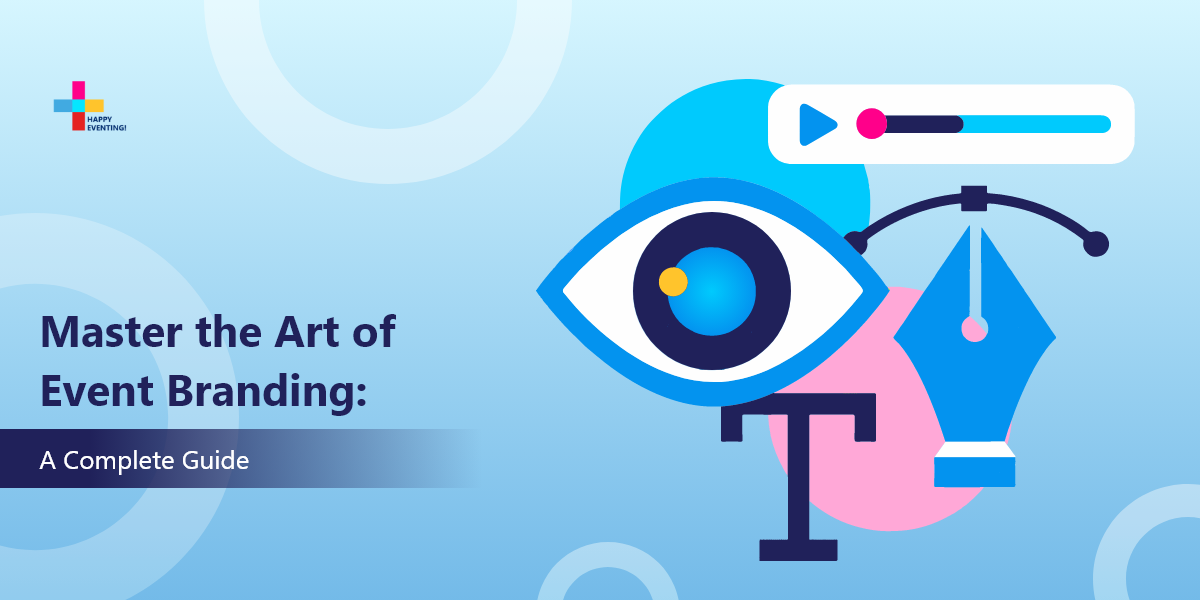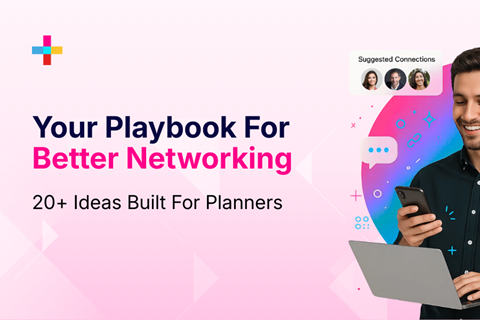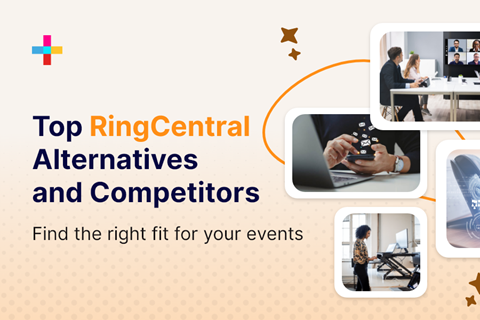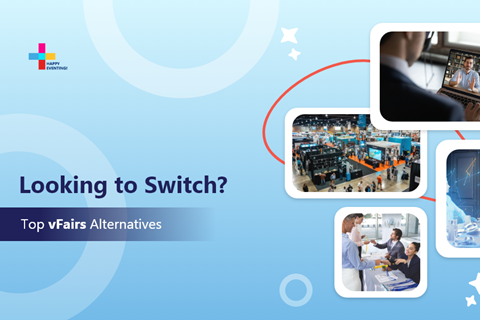

Most B2B event branding still blends into the background. Generic signage. Disposable swag. Forgettable themes.
Yours can be different with properly executed event branding. Effective event branding isn’t just about a logo on a step-and-repeat or a catchy slogan on a tote bag. It’s about crafting an identity, a vibe, and an experience people remember. It’s the first impression, the emotional hook, and the reason people remember your event over anyone else’s.
This guide is your shortcut to doing just that. how to build branding strategies that actually means something — to your audience, your sponsors, and your bottom line.
Event branding is the intentional creation of a unified visual and emotional identity for your event through visuals, messaging, and experiences. It’s the logo on your signage, the tone of your emails, and the vibe of your venue, all designed to make your event stand out.
Done right, branding turns your event from just another calendar invite into a brand experience people remember.
Event branding is important because it directly influences how your event is perceived before it even begins.
It tells attendees what to expect, signals value, and shapes whether they choose to register, attend, or sponsor. In the B2B space, where decisions are strategic, branding often determines how your event is judged—long before the first session kicks off.
The main benefit of event branding is that it makes your event memorable, credible, and effective at engaging your target audience.
1. Sets your event apart from the competition.
2. Builds trust with attendees and sponsors.
3. Creates a clear, consistent narrative to boost engagement.
4. Signals professionalism in a crowded B2B market.
5. Aligns your event with key business objectives.
Building strong event branding means creating a consistent and memorable identity that sticks with your audience long after the event ends. Here’s how to nail it:
1. Clarify Your Mission
Pin down exactly why your event exists. Whether it’s sparking industry innovation, connecting decision-makers, or showcasing new trends, a clear mission sets the tone for everything else.
2. Define Your Values
Your event’s personality comes from its core values. Are you professional and polished, bold and disruptive, or collaborative and community-driven? These values shape your messaging and design.
3. Know Your Audience
Understand who you’re speaking to. Are they executives, specialists, or influencers? Tailoring your branding to their preferences and expectations makes your event relevant and compelling.
4. Create a Visual Identity
Design a style guide that covers your logo, color palette, fonts, and overall look and feel. A tech event might lean sleek and modern; a finance conference might be clean and formal. This visual language needs to scream your event’s personality.
5. Be Consistent Everywhere
Apply your branding across all touchpoints—website, social media, signage, badges, apps, presentations, and sponsor materials. Consistency builds trust and makes your event look professional and polished.
6. Test and Refine
Before the big day, review every branded asset to ensure it aligns perfectly with your style guide. Small mismatches can chip away at your credibility.
Effective B2B event branding relies on specific, well-executed elements, that create a unified, professional experience. Each must align with your brand identity to deliver meaningful impact. Here are the key components:
1. Landing Page
Your event landing page is ground zero for your branding. Brand it with your logo, colors, and fonts. Use customizable templates to control layout, backgrounds, and images so everything reflects your identity. Include strong calls to action like “Register Now” and messaging that ties directly to your event’s mission. A polished page builds credibility and drives conversions.
2. Social Media Creatives
Your event lives on LinkedIn, X, and anywhere your audience scrolls—so your creatives need to speak the same visual language. Create consistent visuals for session teasers or speaker highlights to build anticipation. Branded creatives boost engagement, attracting attendees and sponsors.
3. Event App
Your app is the digital extension of your brand during the event. Brand it thoroughly—from splash screens to button colors—and pack it with real-time features like schedules, Q&As, networking, and document access. This keeps attendees engaged and informed, while every tap reinforces your identity and professionalism.
4. Signage and Banners
From welcome arches to breakout room boards, signage should echo your brand’s tone with clear design and consistent visuals. Use professional signage at registration desks, session rooms, and networking areas, incorporating your logo and colors. Consistent signage creates an organized, welcoming atmosphere and strengthens brand recognition.
5. Name Badges and Lanyards
Badges and lanyards are wearable touchpoints that carry your brand through the crowd. Design badges using consistent brand elements—logo, colors, font styles—and include QR codes for fast check-ins or lead capture. Tailor badge sizes and materials to your event type. Pair them with branded lanyards to add a polished, professional look. Together, they simplify networking, speed up entry, and keep your brand front and center.
6. Presentation Slides and Digital Displays
These are the visual anchors of your content delivery. Apply your brand style guide to speaker slides and venue screens. Correct branding in these touchpoints elevates the speaker’s message, keeps audiences focused, and signals to attendees (and sponsors) that your event is buttoned up and credible.
7. Printed Materials
Whether it’s an agenda, brochure, or takeaway sheet, printed materials should feel intentional and on-brand. Match your visual style, keep layouts clean, and use eco-friendly paper where possible. These pieces are often what attendees carry home, so they should reflect the same professionalism as the rest of the event.
These 8 strategies ensure your B2B conference or trade show excels in 2025. Each point explains its execution, effectiveness, and impact, creating a logical narrative and cohesive brand that drives engagement and success.
1. Define Your Event’s Core Identity
Start with clarity. Establish a mission, set of values, and a defined audience to guide every branding decision. A cybersecurity summit themed “Zero Trust, High Value” will look and feel completely different from a healthcare forum focused on “Human-Centered Innovation.” You can’t build a brand until you know what you stand for.
2. Create a Consistent Visual System
Build a style guide that includes a scalable logo, professional color palette, and versatile fonts. Apply it across all event materials—from signage and badges to digital slides and mobile apps. Visual consistency signals professionalism and makes your event instantly recognizable.
3. Drive Engagement with Platform-Specific Content
Tailor content for each platform. Use LinkedIn or X to run targeted campaigns, share branded graphics, post session teasers, or highlight speakers. Create event-specific hashtags to boost sharing. This not only builds anticipation but also reinforces your event’s identity while drawing in attendees and sponsors.
4. Design Memorable Attendee Touchpoints
Craft branded badges, lanyards, and signage at registration desks or common lobbies. These physical touchpoints create a strong first impression, make attendees feel valued, and encourage positive word-of-mouth.
5. Design a Distinct Visual Theme for the Year
Want attendees to remember this year vs. last? Anchor your branding with a bold visual direction—a new theme color, visuals, or design concept that reflects the current focus or mood of the event. It signals freshness while staying within your brand identity.
6. Maintain Brand Consistency Across Event Tech Platforms
From registration pages to mobile event apps and virtual sessions, branding should feel seamless across every digital touchpoint. No clashing layouts, no mismatched fonts. Your online presence should match the experience on-site—fluid, professional, and on-brand.
7. Brand Your Agenda Structure
Go beyond basic labels like “Track 1” or “Panel A.” Name your content streams with titles that match your brand tone or event theme. It shows intentionality and adds personality to your programming.
8. Integrate Gamification Aligned with Your Brand Message
Add purpose to your event’s fun factor. Use interactive challenges in your event app—like quizzes on industry topics or networking competitions—to reinforce your core themes. These moments don’t just boost engagement; they make your brand feel more tangible and relatable. It’s branding delivered through experience.
In 2025, event technology is not just a logistical tool—it's a pivotal element in crafting and reinforcing your event's brand identity. An event tech platform, especially one that allows 100% white labeling, you can create a cohesive, immersive brand experience that resonates with attendees at every touchpoint. Here's how:
1. Branded Registration Flows
Your event's branding journey begins the moment an attendee registers. Utilize registration platforms that allow customization to reflect your brand's colors, fonts, and messaging. Incorporate personalized welcome messages and tailored content suggestions based on attendee profiles to make a strong first impression.
2. Customized Email Communications
Leverage email marketing tools to send branded communications throughout the event lifecycle. From confirmation emails to post-event follow-ups, ensure each message aligns with your brand's tone and visual identity. Segment your audience to deliver personalized content that enhances engagement and reinforces your brand's relevance.
3. Branded Event Apps
An event app serves as a central hub for attendees, offering schedules, speaker bios, networking opportunities, and more. Customize the app's interface to mirror your brand's aesthetics, and incorporate features like push notifications and interactive maps to enhance the user experience. A well-branded app keeps your identity front and center throughout the event.
4. Interactive Polls and Q&A Sessions
Engage attendees with live polls and Q&A sessions during presentations. Use platforms that allow branding customization, ensuring that these interactive elements are visually consistent with your event's theme. This not only fosters participation but also reinforces brand recognition.
5. In-App Chat and Networking Features
Facilitate connections among attendees through in-app chat functionalities. Customize chat interfaces to reflect your brand, and consider features like AI-driven matchmaking to pair attendees with similar interests or goals. Branded networking experiences enhance the sense of community and align with your event's objectives.
6. Virtual and Hybrid Platform Branding
For virtual or hybrid events, ensure that the digital platform is an extension of your brand. Customize virtual backgrounds, session layouts, and navigation menus to maintain brand consistency. Incorporate branded waiting rooms and transition screens to keep attendees immersed in your event's identity.
7. Post-Event Surveys and Feedback Forms
Collecting feedback is crucial, and the tools you use should reflect your brand's professionalism. Design surveys and feedback forms that align with your visual identity, and personalize them to show appreciation for attendee participation. This attention to detail reinforces your brand's commitment to excellence.
We’ve emphasized how crucial event branding is. But effective branding doesn’t happen by chance—it requires careful budget planning and early integration in your event strategy. Here’s how to maximize impact without overspending:
1. Prioritize High-Impact Elements
Focus your investment on essentials like a professional logo, a well-designed event app, and technology that enhances attendee experience while delivering solid ROI.
2. Leverage Digital Promotions
Branded social media posts and targetted emails reach your audience and sponsors effectively, reducing the need for expensive printed materials.
3. Use Reusable Materials
Choose durable signage and banners that can be refreshed and reused across multiple events to extend your budget’s reach.
4. Incorporate Eco-Friendly Options
Sustainability matters—select recyclable badges, digital programs, and environmentally responsible materials to resonate with today’s audiences.
5. Plan Early
Allocating your branding budget well in advance helps avoid last-minute expenses and ensures a polished, consistent look throughout your event.
Successful event branding happens when every detail—from technology to touchpoints—works in sync to tell your story authentically. It’s not just about looking good; it’s about creating moments that stick with your audience because they feel intentional and aligned with who you are. Using a platform that gives you real control means you can craft an experience that’s unmistakably yours, every step of the way.
When branding and tech come together thoughtfully, your event doesn’t just get noticed—it gets remembered for the right reasons.
Schedule a demo call today and see how you can take full control of your event branding with Eventcombo. Let’s make your next event unmistakably yours.

Networking events remain the backbone of professional growth, whether you're building a business, recruiting talent, generating leads, or seeking strategic partnerships.

RingCentral Events is a known name in the event platform space. It supports in-person, hybrid, and virtual formats, but today’s event programs need far more depth within each format.

The industry has made it clear that event management platforms must support multiple formats with consistency. This shift has led many professionals to explore vFairs alternatives that provide full event management.